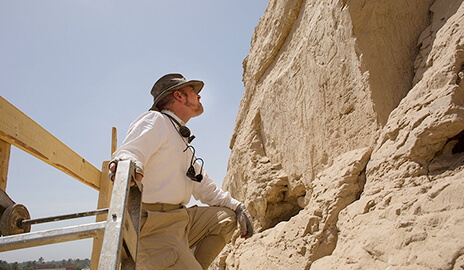Researchers from Yale University and Royal Museums of Art and History in Brussels have discovered large, revolutionary hieroglyphic carvings in the eastern-Egyptian village of El-Khawy.
The rock carvings, which date back 5,200 years to the first hieroglyphics, were discovered on an expedition to the ancient Egyptian city of Elkab.
“This newly discovered rock art site of El-Khawy preserves some of the earliest — and largest — signs from the formative stages of the hieroglyphic script and provides evidence for how the ancient Egyptians invented their unique writing system,” said John Coleman Darnell, an Egyptologist and Yale professor in the Department of Near Eastern Languages and Civilization and co-director of the Elkab Desert Survey Project, in a statement.
Previously-identified hieroglyphics stand only one to two centimeters tall, but the newly found rock carvings are 70 centimeters in height.
What They Found
Initially, researchers came across a carving of a herd of elephants, which could date back to 4,000-3,500 B.C.E. One of the elephants has a smaller elephant drawn inside of it, which depicts pregnancy.
Additionally, researchers discovered a four-sign panel, reading right to left, dating to 3,250 B.C.E. The first panel has imagery depicting a bull’s head on a short pole. This is followed by two panels with carvings of saddlebill storks with a bald ibis bird above and between them.
Similar arrangements of the symbols have been recorded in previous finds. They have been known to depict the Egyptian interpretation of the solar cycle with the concept of luminosity. “These images may express the concept of royal authority over the ordered cosmos,” Darnell said in a statement.
What This Means
The immense age and size of the finds give historical evidence to the origins and expansivity of ancient hieroglyphics.
Darnell informed TUN that the earliest true hieroglyphics known from Egypt are in tomb U-j at Abydos, and date to circa 3250 B.C.E. These hieroglyphics essentially mark the start of a politically unified southern state called Dynasty 0, which was a precursor to Dynasty 1, the first period of unified Egypt.
“The el-Khawy early hieroglyphic inscription is paleographically of an early Dynasty 0 date, and shows that the early script was relatively widespread, and also used for more than simply administrative purposes,” said Darnell.
Darnell explained that the inscriptions found in the tomb at Abydos are only a couple of centimeters tall, but the carvings found at el-Khawy are over a half meter in height. “The large scale of the newly discovered early dynastic inscription at el-Khawy, on a route, and high on a rock surface for maximum visibility, also imply that the signs could convey some meaning to travelers on the road, even if few of those travelers at that early stage of writing were fully literate,” said Darnell.
Darnell hopes that this discovery will help reveal additional early hieroglyphic carvings in the upper Egyptian regions of Elkab and Hierakonpolis.
“The appearance of the early hieroglyphic script in the Elkab/Hierakonpolis region suggests that the script—even if developed in its final form in the region of Abydos—was very early in use in the area of Hierakonpolis, the most important center of Upper Egyptian cultural development prior to an apparent shift to Abydos about 3250 BCE,” explained Darnell. “I hope we may find more evidence of Dynasty 0 activity elsewhere in the region.”





